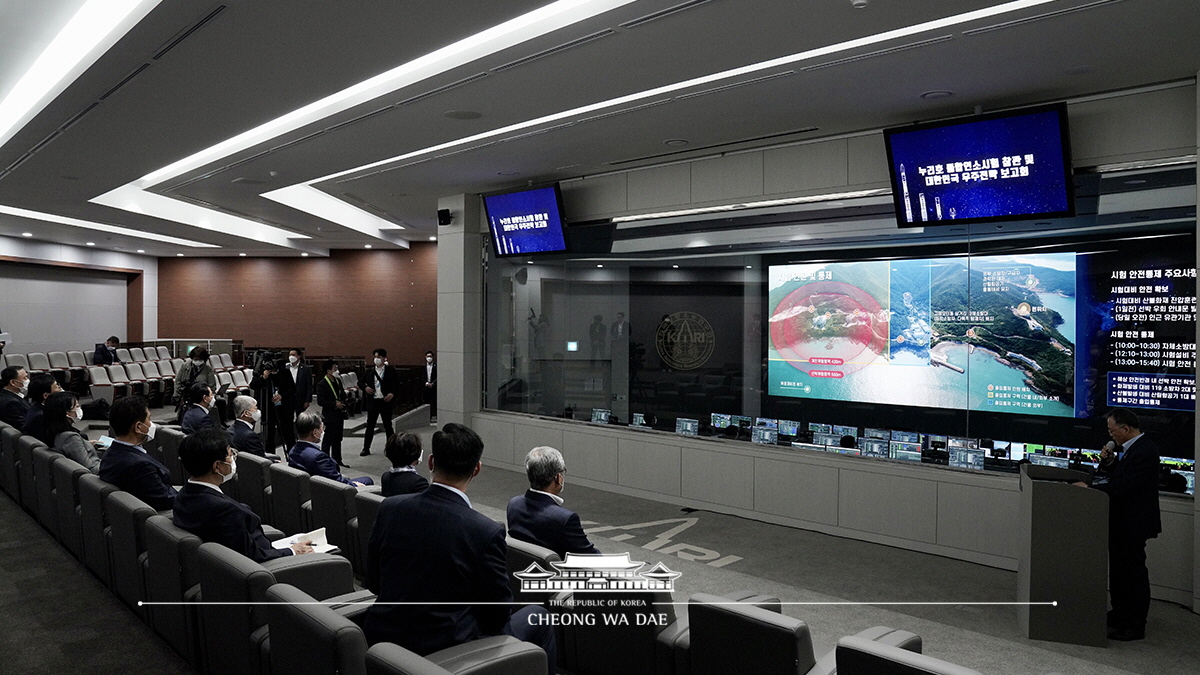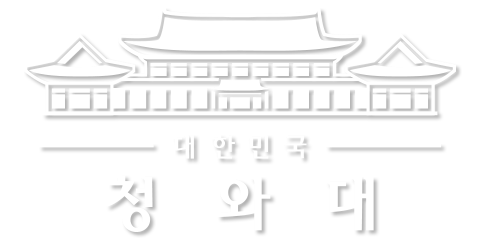이 웹사이트는 제19대 대통령 임기 종료에 따라 대통령기록관이 「대통령기록물 관리에 관한 법률」에 의해 이관받아 서비스하는 대통령기록물입니다. 자료의 열람만 가능하며 수정 · 추가 · 삭제는 불가능합니다.
다만, 「개인정보보호법」에 의하여 개인의 정보를 보호받기 원하시는 분은 관련 내용(요청자, 요청내용, 연락처, 글위치)을 대통령 웹기록물 담당자(044-211-2253)에게 요청해 주시면 신속히 검토하여 조치해 드리겠습니다. 감사합니다.
SPEECHES & REMARKS
BRIEFINGS
Remarks by President Moon Jae-in at Space Strategy Presentation for Korea Following Nuri Thrust Engine Combustion Test

Fellow Koreans, space scientists and engineers,
I am proud of you. Congratulations on the successful final integrated hot-fire test of Nuri’s first-stage thrust engine today. This last test simulating the actual launch of Korea’s newest space launch vehicle signifies the completion of its development. All that remains is Nuri’s lift-off.
The second- and third-stage boosters of Nuri’s three-stage rocket engine have already proven their abilities. Today’s successful ground test of the four clustered 75-ton rocket engines has completed development of even the most difficult part to assemble, the first-stage booster, which provides the greatest thrust. At long last, Nuri is ready to fly into space in October, carrying a dummy satellite.
The 2013 lift-off of Korea Space Launch Vehicle-I Naro required assistance from Russia. However, dispelling any sense of having come up short, we are now able to put our own satellite into orbit using our own space launch vehicle from our own territory. Korea becoming only the 7th country to do this is a very proud achievement.
Even when Korea was suffering from the Asian financial crisis, then-President Kim Dae-jung with our people envisioned space exploration and decided to develop a launch vehicle. Twenty years later, our researchers and businesses, with the Korea Aerospace Research Institute playing a pivotal role, have jointly pulled off today’s single-minded accomplishment amid public support. I encourage those involved in the success of today’s hot-fire test. My heartfelt respect and gratitude also go to everyone who has worked hard up to this day, long shedding sweat and tears. In particular, I am grateful once again to the many business leaders who have participated in this project over such a long time.
Fellow Koreans,
The world’s first spacecraft was launched in 1957, and humanity left its first footprints on the Moon in 1969. These stories that aroused envy seemed to only come from a distant land, but the era of the Republic of Korea’s space exploration has now come into sight. It has now become possible for us as well to put our satellites into orbit on launch vehicles that we have built, and we have entered in earnest a new space race with the private sector leading the innovative space industry. The Government will make our dream a reality together with the people. With a long-term vision and unwavering commitment, we will boldly invest in space development and venture out into space along with the scientists and engineers.
First, we will actively push for challenging space exploration projects that build on the foundation achieved by developing a Korean launch vehicle. Next year, Korea Pathfinder Lunar Orbiter will be launched, and by 2030, we will achieve our dream of landing on the Moon by using our own launch vehicle. The technological prowess, experience and confidence that will be gained from exploring the Moon, the first step in space exploration, will provide a solid foundation for space development. Also regarding Apophis, an asteroid that will pass near Earth in 2029, an exploration plan will be established following feasibility studies.
Second, we will spur development and the utilization of a variety of satellites. We now live in an era when satellites are used to navigate and manage the environment and land. To date, we have sent 17 satellites into space. Nine of them have completed their missions, and eight are still carrying out various others in Earth’s orbit, ranging from broadcast and telecommunications to land and environmental management.
Launched last year, the Chollian 2B is the world’s first geostationary satellite for fine dust observation, and it is sharing information with 13 Asian countries for clear skies. On March 22, our first next-generation, medium-sized satellite was put safely into orbit. This satellite will watch our territory closely to help us manage natural resources and respond to disasters and catastrophes.
Our satellite technology is highly competitive to an extent that Korea-made satellite systems and payloads are exported to many countries around the world. We will continue to develop technological prowess by establishing a pilot network of communication satellites to usher in the 6G era, a Korean-engineered satellite navigation system essential for the autonomous vehicle and drone industries, and a nano-satellite constellation system to strengthen our space-related national defense.
Third, efforts will be made to enhance private sector-led space development capabilities. We will build an innovative industrial ecosystem so that global space companies such as SpaceX can also be created in Korea. Technology owned by state-funded research institutes will be transferred to the private sector in stages. We will pursue institutional improvement as planned to establish a space industry cluster and vitalize the space service industry.
Of note, a revision to the Korea-U.S. missile guidelines last year has enabled us to use solid fuel, providing an excellent opportunity. We will actively support the growth of private-sector launch vehicle companies by installing a site for solid-propellant launches at the Naro Space Center. The status of the Korea National Space Committee’s chairperson will be elevated with the Prime Minister taking on that post. We will combine the capabilities of the public and private sectors more closely and definitely leap forward to become one of the world’s seven leading space powerhouses.
Fellow Koreans and space scientists and engineers,
Young people who began to dream after watching “Our Star,” the KITSAT satellites, being launched in the 1990s are now ushering in the Republic of Korea’s space age. Our children who have seen the successful hot-fire test of Nuri’s first-stage thrust engine today will go beyond the Moon to reach Mars and move further out into the vast universe.
Our science and technology have already become world class in many areas. In the aerospace field, however, it is true that we have yet to narrow the technology gap. Nevertheless, if we continue our dream of going to space while looking at the stars in the night sky, Korea will undoubtedly be able to leap forward to become a pacesetter in the aerospace field as well.
We cheer the dream and passion of space scientists and engineers who continue to take on challenges without fear of failure. Today’s success has given great hope to our people who have grown weary due to the COVID-19 pandemic. The people will also provide unwavering support. Thank you, everyone.
I feel very proud today. Once again, I join the people in congratulating you.
Thank you.



